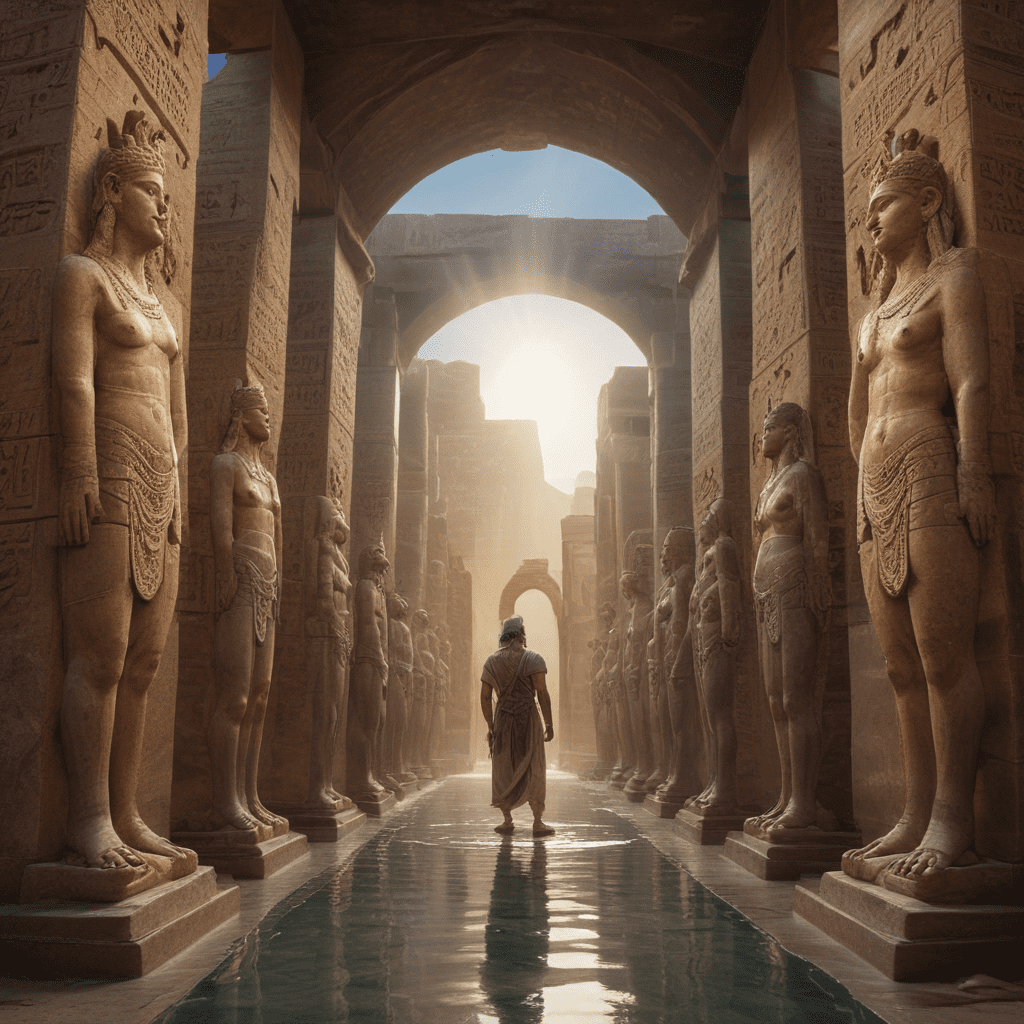The Myth of Lahmu and Lahamu: Primordial Deities in Mesopotamian Mythology
Introduction: The Dawn of Creation
Mesopotamian mythology, born on the fertile plains between the Tigris and Euphrates rivers, boasts a rich tapestry of creation myths. Among the most celebrated is the Enuma Elish, a Babylonian epic that narrates the dramatic genesis of the world. This tale begins with the primordial waters, Tiamat and Apsu, representing chaos and order, respectively. From their union emerged the first generation of gods, Lahmu and Lahamu, who set the stage for the unfolding drama of creation.
Lahmu and Lahamu: The First-born Deities
Emerging from the primordial waters of Apsu, Lahmu and Lahamu hold the distinction of being the first-born deities in Mesopotamian mythology. Their names, meaning "mud" and "slime" respectively, underscore their connection to the primordial watery chaos from which they arose. As the first divine offspring of Tiamat and Apsu, Lahmu and Lahamu bridged the gap between the formless abyss and the organized world that would follow.
The Divine Lineage of Lahmu and Lahamu
Lahmu and Lahamu, in their divine union, gave birth to the next generation of gods, Anshar and Kishar, representing the celestial heavens and the earthly firmament. This divine lineage established a hierarchical order within the Mesopotamian pantheon, with Lahmu and Lahamu occupying a pivotal position as the progenitors of the subsequent generations of gods.
The Role of Lahmu and Lahamu in Mesopotamian Mythology
Lahmu and Lahamu played a multifaceted role in Mesopotamian mythology. As the first-born deities, they served as the divine progenitors, giving rise to the entire pantheon of Mesopotamian gods. Their connection to the primordial waters symbolized their role as the source of all creation. Additionally, they embodied the concept of chaos and order, representing the transition from the formless abyss to the structured world.
The Enduring Power of Myth
The myth of Lahmu and Lahamu offers valuable insights into the Mesopotamian worldview, reflecting their understanding of creation and the complex relationship between chaos and order. Even today, this ancient myth continues to resonate with its powerful imagery and profound symbolism, reminding us of the enduring power of human imagination and storytelling.
Literary and Artistic Representations of Lahmu and Lahamu
The myth of Lahmu and Lahamu finds expression not only in textual sources but also in artistic representations. The most prominent example is the Enuma Elish tablet, a clay tablet inscribed with the Babylonian creation myth. This tablet, housed in the British Museum, depicts the primordial gods emerging from the watery abyss, with Lahmu and Lahamu appearing among the first divine figures.
Cylinder seals, another significant form of Mesopotamian art, often feature images of Lahmu and Lahamu. These cylindrical-shaped seals, used to impress designs on clay tablets, often showcase divine figures and mythological scenes. Depictions of Lahmu and Lahamu on cylinder seals typically portray them as anthropomorphic figures, often standing or seated, with their names inscribed alongside them.
The artistic representations of Lahmu and Lahamu highlight their importance within the Mesopotamian pantheon. Their presence on the Enuma Elish tablet and cylinder seals underscores their role as primordial deities and underscores their significance in Mesopotamian mythology and art.
The Significance of the Lahmu and Lahamu Myth Today
The myth of Lahmu and Lahamu holds relevance even in contemporary times. By delving into this ancient Mesopotamian narrative, we gain valuable insights into the beliefs and values of a long-gone civilization.
The myth sheds light on the Mesopotamian understanding of creation, revealing their perception of the world as emerging from a primordial watery chaos. It also provides insights into the Mesopotamian concept of divine hierarchy, showcasing Lahmu and Lahamu as the progenitors of the subsequent generations of gods.
Moreover, the myth's exploration of the interplay between chaos and order offers a timeless message. It reminds us of the delicate balance between these opposing forces, and the role of creation in bringing order out of chaos.
Conclusion: From Chaos to Creation
The myth of Lahmu and Lahamu stands as a testament to the human imagination and its enduring fascination with the origins of the universe. This Mesopotamian narrative, born out of the ancient fertile plains, offers a rich tapestry of symbolism and insights that continue to resonate with audiences today.
The story of Lahmu and Lahamu, emerging from the primordial waters to become the progenitors of the gods, reminds us of the transformative power of creation. It speaks to the human yearning to understand our place in the cosmos and the enduring power of myth to shape our understanding of the world around us.
The legacy of Lahmu and Lahamu extends beyond the realms of mythology and into the realms of human culture. Their names echo in the depths of our imagination, reminding us of the origins of our universe and the enduring quest to find meaning and order in the vastness of existence.
Frequently Asked Questions (FAQs)
Who were Lahmu and Lahamu?
Lahmu and Lahamu were the first-born deities in Mesopotamian mythology, emerging from the primordial waters of Tiamat and Apsu. They were the progenitors of the subsequent generations of gods, including Anshar and Kishar, representing the celestial heavens and the earthly firmament.
What is the significance of Lahmu and Lahamu?
Lahmu and Lahamu played a pivotal role in Mesopotamian mythology as the source of all creation and as embodiments of the transition from chaos to order. Their myth provides insights into Mesopotamian beliefs about the origin of the universe, divine hierarchy, and the interplay between chaos and order.
How are Lahmu and Lahamu represented in art and literature?
The myth of Lahmu and Lahamu is depicted in the Enuma Elish tablet, a Babylonian creation myth inscribed on clay tablets. They are also featured on cylinder seals, cylindrical-shaped objects used to impress designs on clay tablets. These artistic representations highlight the importance of Lahmu and Lahamu within the Mesopotamian pantheon.
What is the relevance of the Lahmu and Lahamu myth today?
The myth of Lahmu and Lahamu continues to hold relevance in contemporary times by offering insights into ancient Mesopotamian beliefs and values. It sheds light on their understanding of creation, divine hierarchy, and the balance between chaos and order. Moreover, the myth serves as a timeless reminder of the human fascination with the origins of the universe and the power of creation to bring order out of chaos.




